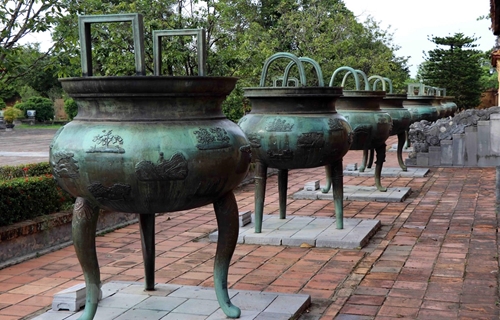The Hue Monuments Conservation Centre has completed the compilation of a dossier for the national treasure of “Cuu dinh” (Nine Dynastic Urns) to seek UNESCO recognition as a world documentary heritage.
The dossiers will be submitted to the Ministry of Culture, Sports and Tourism for consideration and recommendations before seeking UNESCO’s recognition, said Dr. Le Thi An Hoa from the centre.
Comparative cultural studies in Japan, China, and the Republic of Korea showed that the set of tripod urns currently displayed in the citadel of Hue is the only existing one of its type.
The intact urns are horizontally placed at the yard of the Hue Imperial Citadel (Dai Noi)’s The To Mieu (To Mieu Temple), a place to worship the kings of the Nguyen Dynasty – the last feudal regime of Vietnam which ruled the country from 1802 to 1945.
All cast in bronze, they represent the unity and the beauty of the country as well as sustainable existence of the Nguyen Dynasty.
    |
 |
|
Cuu dinh” (Nine Dynastic Urns) are placed in front of the Hien Lam Pavilion inside The To Temple in the Hue Imperial Citadel (Dai Noi) for over 200 years. |
Also outstanding symbols of the country’s immortal reign and wealth, the urns were built in late 1835 and completed in early 1837, under the reign of King Minh Mang.
The highest urn is 2.5 meters high versus the shortest at 2.3 meters high. Each one, weighing up to 2,600kg, has a name symbolising an emperor of the Nguyen Dynasty. The central one is dedicated to Gia Long emperor.
Their craftsmanship is remarkable, making the symbolism of power, stability, and continuity even stronger.
The urns can also be considered a “geographic encyclopedia” of Vietnam in the 19th century with 162 carved patterns exquisitely embossed on their surface depicting popular landscapes, like universe, rivers, mountains; and daily activities across the country, including 90 images of typical plants and animals. These create a great combination between carving and bronze casting. Until now, all of them are still in their original position and remain intactly.
Of note, the country’s sea and islands were carved on the three largest and most significant urns. The East Sea (South China Sea) is depicted on the “Cao Urn,” the one positioned in the very middle and higher than the others, which is dedicated to King Gia Long, the first king of Nguyen Dynasty. The southern sea appeared on the Nhan Urn, and the western sea on the Chuong Urn.
Alongside various ancient documents, the patterns on the urns serve as a valuable historical source affirming Vietnam’s sovereignty over the Hoang Sa (Paracel) and Truong Sa (Spratly) archipelagos.
According to experts, the urns were cast by the best craftsmen at the time. Their molds were destroyed upon the completion to avoid counterfeits, making them the only one of the kind.
The Hue Monuments Conservation Center is confident that the aforementioned factors qualify these urns as world documentary heritage in accordance with the criteria set by the UNESCO’s Memory of the World Program.
In addition to the set of Nine Dynastic Urns, the Imperial Citadel of Hue boasts many other ancient works and items under the Nguyen Dynasty.
Among those, the woodblocks used to print books of Han characters, or adapted Chinese characters, were recognised as the world’s documentary heritage by the UNESCO in 2009, and the imperial records and literature on the royal architecture were acknowledged with a similar title by the Memory of the World Committee for Asia and the Pacific in 2014 and 2016, respectively.
Source: VNA